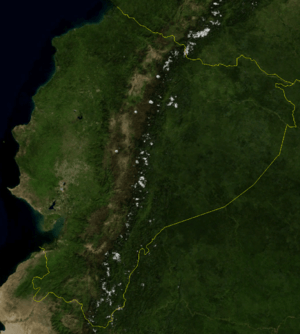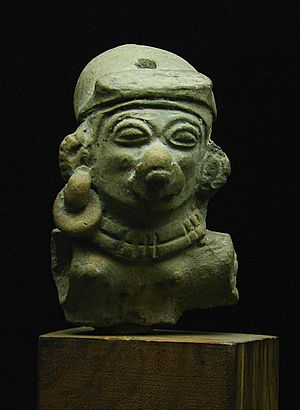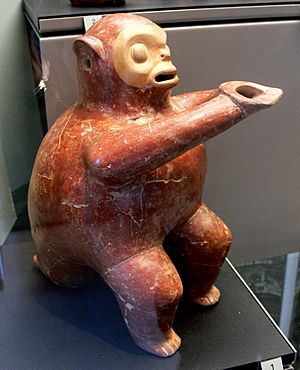Chorrera culture facts for kids

Location of the Chorrera culture
|
|
| Geographical range | Ecuador |
|---|---|
| Period | Formative |
| Dates | c. 1300 - 300 BCE |
| Preceded by | Machalilla |
| Followed by | Bahía, Tuncahuán |
The Chorrera culture was an ancient group of people who lived in Ecuador a very long time ago. They existed between about 1300 BCE and 300 BCE. This makes them a "Late Formative" culture. The Chorrera people were one of the most widespread groups in pre-Columbian Ecuador. This means they lived in many different areas. Their lands stretched from the Pacific coast to the Andes mountains. They even lived in parts of southern Colombia.
Contents
Where the Chorrera People Lived
The Chorrera culture covered a large area. Because of this, their pottery and other items changed a bit from place to place. Scientists have divided the Chorrera culture into different regional groups. This helps us understand how they lived across their lands.
Here are some of these regional groups:
- Mafa Phase, in northern Esmeraldas Province
- Tachina Phase, in southern Esmeraldas Province
- Tabuchula Phase, in northern Manabí Province
- Engoroy Phase, near the Santa Elena Peninsula and Guayas coast
- Chorrera proper, in the Guayas River Basin
- Early Jubones Phase, in southeastern Guaya and western Azuay Province
- Arenillas Phase, in El Oro Province
Other nearby regions also showed a strong influence from the Chorrera culture.
Amazing Chorrera Pottery
The Chorrera culture is famous for its amazing pottery. They made special Stirrup spout vessels that could whistle! These bottles were often shaped like animals or plants. They also made human figures using molds. Even their everyday pots were very well made. They had thin, decorated walls. Many were polished to a shiny red or black finish.
Artists would decorate bowls, bottles, and other items. They used tools to carve designs into the clay. They also painted, polished, or stamped patterns onto the surfaces. Chorrera people even used pottery for personal decorations. For example, they made ceramic ear spools. They also used stamps made of pottery to paint their bodies. Some of their pottery had unusual decorations. These included "resist-painting" and shiny, rainbow-like finishes.
First Metalworkers in Ecuador
The Chorrera people were among the first in Ecuador to work with metals. Archaeologists found many metal objects at a coastal site called Salango. These items were made from copper, silver, and gold. Most of these metal objects were fancy goods, like jewelry. They were likely used by important people in the community.
What the Chorrera People Ate
The Chorrera people grew many different crops for food. These included achira (a root vegetable) and arrowroot. They also grew corn, common beans, gourds, and squash. Besides farming, they gathered wild fruits from trees. They also collected sedge plants and palm fruits.
The Chorrera people were also skilled hunters and fishers. They caught animals like armadillos, deer (including white-tailed and brocket deer), ducks, frogs, and lizards. They also hunted peccaries (a type of wild pig) and various small rodents.
Chorrera Trade Networks
The Chorrera culture continued a busy trading system. This system was first set up by earlier cultures like the Valdivia culture and Machalilla cultures. Chorrera fishermen traded spiny oyster shells (called Spondylus) and other seashells. They traded these with people from the Quito basin. In return, they received obsidian, a sharp volcanic glass. In later centuries, they also traded gold.
The End of the Chorrera Culture
Around 467 BCE, a big event changed the Chorrera culture. The Pululahua Volcano, located north of Quito, erupted. This eruption sent volcanic ash over much of western Ecuador. The ash greatly affected the Chorrera way of life. However, some Chorrera settlements in the far north and south continued for several more centuries. These groups slowly changed and developed into new, more complex cultures. These new cultures appeared around 200 to 300 BCE.
See also
 In Spanish: Cultura chorrera para niños
In Spanish: Cultura chorrera para niños



